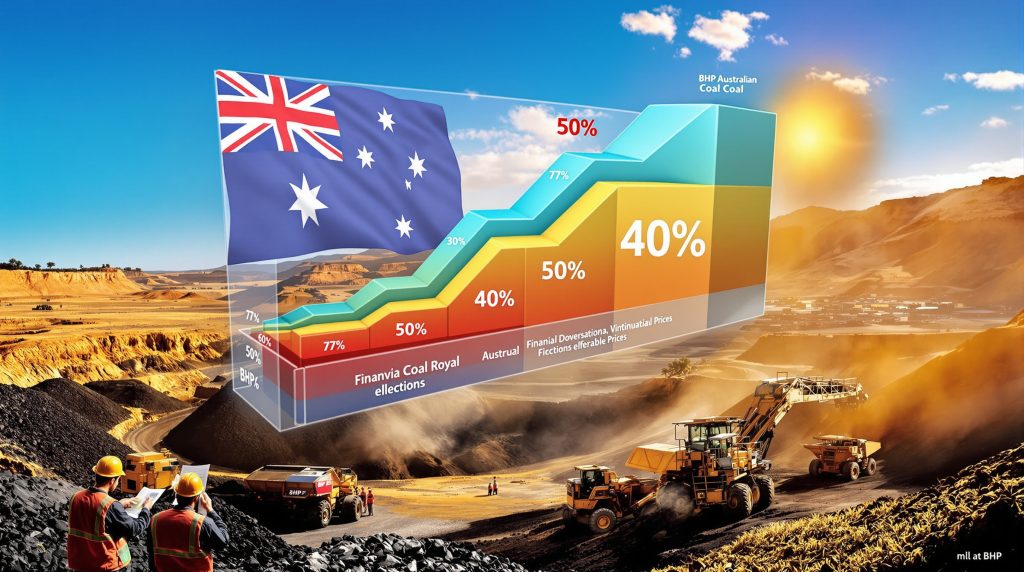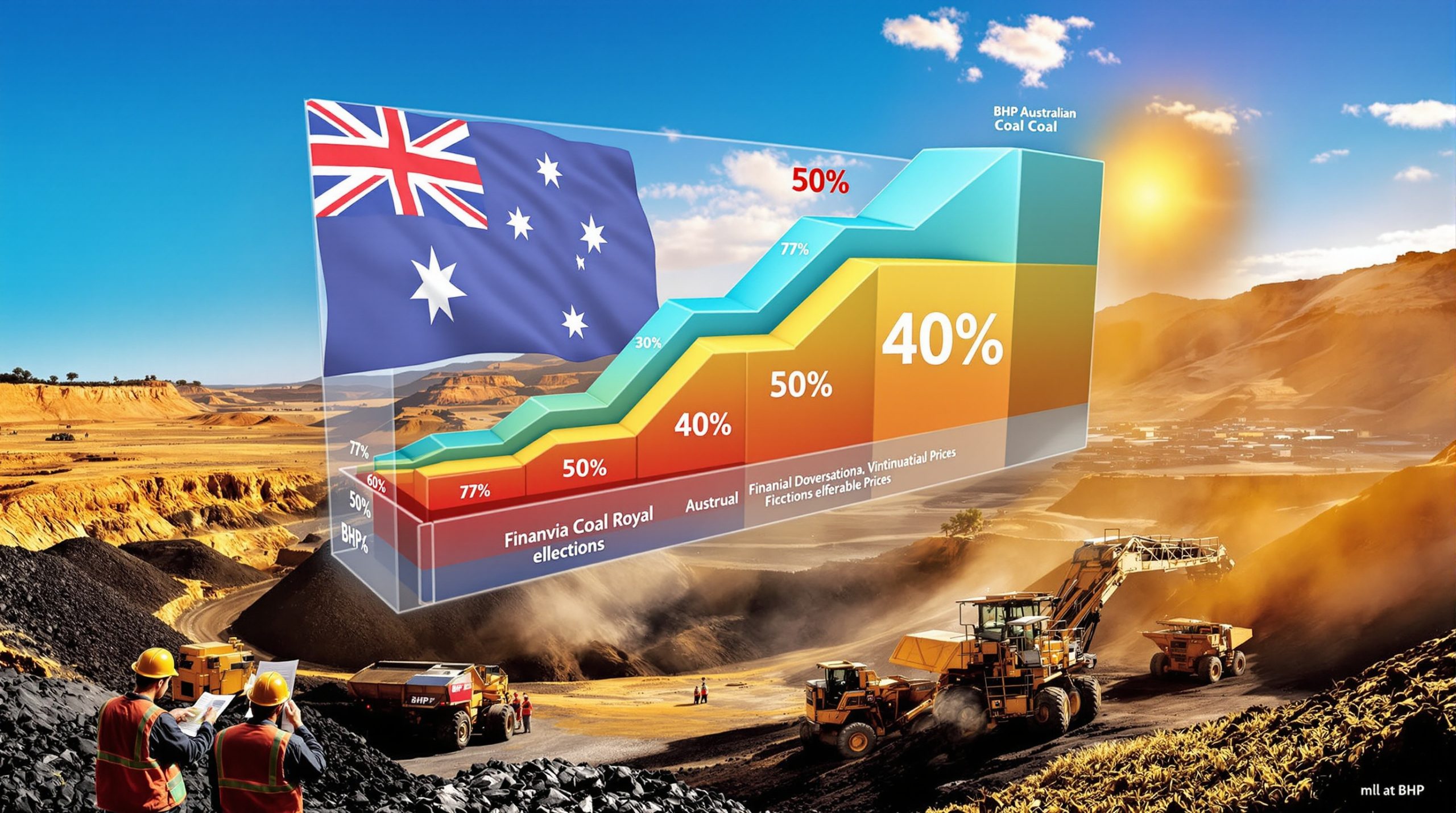How Did Queensland's Coal Royalty System Change?
The Progressive Tier Structure Explained
Queensland's coal industry experienced a significant taxation overhaul in 2022 with the implementation of a six-tier progressive royalty system. This reform marked a departure from the previous flat-rate approach that had been in place for decades. Under the new structure, coal producers pay a base rate of 7% for coal valued up to $100 per tonne, with rates increasing incrementally through each subsequent tier.
The progressive tiers continue with 12.5% applied to coal valued between $100-$150 per tonne, 15% for $150-$200, 20% for $200-$250, 30% for $250-$300, and finally reaching a maximum rate of 40% for coal priced above $300 per tonne. This tiered approach means that as coal prices rise, the government captures a larger percentage of the value, particularly during boom periods when prices spike.
The economic implications of this structural change are substantial. While the previous flat-rate system provided stability and predictability for mining operations, the new progressive system creates variable taxation burdens that fluctuate with market conditions. During periods of high coal prices, royalty payments increase dramatically, while during downturns, the impact is less severe.
Legislative Framework and Protections
To provide stability and prevent arbitrary changes to the royalty structure, Queensland introduced the Progressive Coal Royalties Protection Bill 2024. This legislation established formal requirements for parliamentary approval before any modifications to the royalty rates can be implemented, creating a more transparent process for future adjustments.
Supporting this framework, the Mineral Resources (Royalty) Regulation 2025 provides updated regulatory guidance for industry compliance. These regulations outline reporting requirements, calculation methodologies, and enforcement provisions for the collection of royalties under the new system.
The legal safeguards built into this framework aim to balance government revenue objectives with industry needs for certainty. By requiring parliamentary approval for changes, the system theoretically protects against sudden policy shifts that could destabilize industry planning and investment decisions.
What Economic Impacts Has the Reform Created?
Revenue Generation for Queensland
The reformed royalty structure was projected to generate significant additional revenue for Queensland's public coffers. While precise figures require verification from Queensland Treasury, initial government projections suggested substantial increases in royalty collections during periods of high coal prices.
This additional revenue has been earmarked for public infrastructure development and essential services across the state. Proponents of the system argue that these funds provide critical support for regional development, education, healthcare, and other public priorities that benefit all Queenslanders.
However, the revenue collection pattern has proven highly volatile, closely tracking the fluctuations in global coal prices. During price spikes, treasury collections surge, while during downturns, revenue falls significantly. This volatility creates challenges for budget planning and long-term fiscal management.
Industry Financial Consequences
The financial impact on coal producers has been substantial, with BHP announcing 750 job cuts across its Queensland operations in September 2025. According to Queensland Resources Council, these cuts were directly attributed to the coal royalty regime, with the company also placing a mine into care and maintenance status and reviewing its Future Fit Academy in Mackay.
Queensland Resources Council (QRC) CEO Janette Hewson described the situation as "devastating news for those affected," particularly emphasizing the impact on "workers, families, and communities" in regional areas where alternative employment options may be limited.
Industry representatives have consistently pointed to a challenging economic equation: the combination of increased royalty burdens, declining coal prices in some segments, and rising production costs has created significant financial pressure on operations throughout Queensland. These factors collectively squeeze profit margins and force difficult decisions about continued investment and operations.
How Are Coal Companies Responding to Higher Royalty Rates?
Operational Adjustments and Cost-Cutting Measures
Coal producers across Queensland are implementing various strategies to manage the increased royalty burden. BHP's announcement of 750 job reductions represents the most visible response, with the company specifically citing royalty rates as a driving factor in its decision-making process.
Beyond workforce reductions, companies are pursuing operational efficiency initiatives to reduce production costs and maintain viability. These include optimizing mine plans to focus on higher-grade, lower-cost extraction areas, streamlining maintenance procedures, and reducing administrative overhead.
Some operations are investigating accelerated adoption of automation and digital technologies to reduce labor costs and improve productivity. While requiring initial capital investment, these technologies can deliver significant long-term operational savings that help offset the higher royalty burden.
Industry analysts suggest that Queensland's position in company portfolios is being reassessed, with potential redirection of investment capital to jurisdictions with more favorable taxation environments. This could include both interstate movement within Australia and international reallocation to competing coal regions globally.
Investment Decision Impacts
The longer-term consequences for Queensland's coal sector may prove more significant than immediate operational changes. Mining companies typically plan investments on 10-30 year timeframes, meaning current taxation policies influence decisions about capital allocation for decades to come.
Several planned expansion projects across Queensland are reportedly under review, with companies reassessing economic viability under the current royalty structure. These reviews consider not just current coal prices and costs, but projected market conditions over the full lifecycle of potential investments.
The comparison of Queensland's investment attractiveness against other mining regions has become a central consideration in boardroom discussions. Alternative jurisdictions in Australia and internationally are being evaluated based on geological potential, infrastructure access, workforce availability, and importantly, taxation structures.
For operations near the end of their economic life, the increased royalty burden may accelerate closure decisions, particularly for mines with higher cost structures or lower-quality resources. This could result in reserves being left in the ground that might otherwise have been economically viable under the previous royalty regime.
What Are the Regional Economic Consequences?
Employment and Community Effects
The regional impacts of the royalty reform are particularly acute in mining-dependent communities throughout Queensland. The 750 job losses announced by BHP represent not just individual employment impacts but ripple effects throughout regional economies.
Each direct mining job typically supports multiple indirect positions in supporting industries and services. These include equipment suppliers, maintenance contractors, transportation providers, accommodation services, and retail businesses that rely on mining sector spending. As mining industry evolution continues, these supporting businesses face corresponding reductions in demand.
Regional communities face particular challenges in economic diversification. Unlike metropolitan areas with diverse employment bases, mining towns often have limited alternative industries to absorb displaced workers. This creates potential for population decline, housing market impacts, and reduced community services as economic activity contracts.
While some government and industry initiatives aim to support affected communities, the transition process remains challenging. Retraining programs, small business development support, and infrastructure investments can help mitigate impacts but rarely fully replace the economic activity generated by large-scale mining operations.
Supply Chain Disruptions
The coal industry supply chain extends far beyond mine sites themselves. Rail operators, port facilities, equipment suppliers, and maintenance contractors all form part of an interconnected ecosystem that supports coal production and export.
As mining operations adjust to higher royalty rates through reduced production or complete closures, these supply chain participants face corresponding business impacts. Rail networks may see reduced coal volumes, potentially leading to service reductions or increased costs for remaining users. Port facilities similarly face utilization challenges when export volumes decline.
Equipment suppliers have reported changing procurement patterns, with mining companies delaying non-essential purchases and extending equipment lifecycles to reduce capital expenditure. This creates business planning challenges for suppliers and potentially affects their employment levels and investment decisions.
The mining supply ecosystem is adapting through various strategies, including diversification into other resource sectors, geographical expansion beyond Queensland, and development of service offerings less tied to production volumes. However, these adaptations require time and often involve difficult transition periods for businesses and their employees.
What Arguments Exist For and Against the Current Royalty Structure?
Government Position and Justifications
Proponents of the progressive royalty system emphasize several core principles. First, they highlight that coal resources belong to all Queenslanders, and the state has both a right and responsibility to ensure citizens receive fair value from their extraction. This perspective views royalties not as a tax but as payment for a publicly-owned resource.
The revenue needs for public services and infrastructure represent another key justification. Queensland faces significant funding requirements for healthcare, education, transportation networks, and other essential services. Royalty revenue contributes substantially to meeting these needs, particularly in regional areas where infrastructure demands can be significant.
Defenders of the progressive tier system point to its design principles, which aim to balance stable revenue generation with sensitivity to market conditions. When coal prices fall, royalty rates automatically adjust downward, theoretically providing relief during challenging market periods while capturing greater value during boom times.
Economic modeling supporting the sustainability of the royalty structure suggests that at projected long-term coal prices, Queensland operations remain viable and internationally competitive. These models typically highlight Queensland's other competitive advantages, including high-quality resources, excellent infrastructure, and skilled workforce availability.
Industry Criticisms and Concerns
The Queensland Resources Council has consistently characterized the current system as creating "the world's highest coal royalty rates," arguing this places the state at a significant competitive disadvantage internationally. While this claim requires independent verification, it reflects industry concern about Queensland's relative position in global coal markets.
Industry representatives express particular concern about investment risk perceptions and damage to Queensland's international reputation as a stable mining jurisdiction. They argue that sudden and significant changes to royalty structures create sovereign risk concerns that extend beyond immediate financial impacts to influence long-term capital allocation decisions.
Coal producers highlight long-term viability concerns for marginal operations that operate with tighter profit margins. These mines, often older or working lower-quality resources, may become uneconomic under higher royalty rates, potentially leading to premature closures and stranded assets.
The cyclical nature of coal prices creates additional challenges under the progressive system. When prices fall, operations that expanded or developed during high-price periods may struggle with debt servicing and operational costs, creating financial stress that could have been manageable under a flatter royalty structure.
How Does Queensland's System Compare Internationally?
Global Coal Royalty Benchmarking
Comprehensive international comparison requires detailed analysis beyond available sources, but several key observations can be made about Queensland's position in global coal taxation structures. The progressive nature of Queensland's system differs from many jurisdictions that employ flat-rate royalties, making direct comparison challenging.
The effective tax rate—combining royalties, corporate income tax, and other levies—represents the most meaningful comparison metric across jurisdictions. This total government take varies significantly between countries and even between states or provinces within countries, reflecting different approaches to resource taxation.
Queensland's competitive positioning in the global coal market depends on multiple factors beyond royalty rates alone. These include coal quality, proximity to key markets, infrastructure efficiency, labor productivity, and regulatory environments. High-quality metallurgical coal for steelmaking commands premium prices that can potentially absorb higher royalty rates while remaining competitive.
The optimal balance between government revenue and industry competitiveness remains contested, with different jurisdictions making different trade-offs. Some prioritize maximizing immediate government revenue, while others focus on attracting long-term investment through lower taxation rates.
Case Studies from Comparable Jurisdictions
Other Australian states provide useful comparison points for Queensland's approach. New South Wales, another major coal-producing state, employs a different royalty structure with generally lower rates than Queensland's upper tiers. This creates potential for interstate competition for mining investment within Australia.
Internationally, major coal-producing nations like Indonesia, South Africa, and Colombia each employ distinct approaches to resource taxation. These range from profit-based systems to flat-rate royalties to hybrid models combining multiple elements. Each approach creates different incentives for investment and production.
The outcomes of various royalty approaches on investment and production show mixed results globally. Some jurisdictions with relatively low royalty rates have attracted significant investment but captured less value for public benefit. Others with higher rates have maintained strong production while generating substantial public revenue, particularly where other competitive advantages exist.
Alternative resource taxation models, including profit-based systems rather than revenue-based royalties, offer potential lessons for Queensland. These approaches can better account for operational costs and project economics but may create more complex administration requirements and potential for tax minimization strategies.
What Are the Long-Term Market Implications?
Steelmaking Coal Demand Outlook
The global steel industry continues to require high-quality metallurgical coal for blast furnace operations, creating ongoing demand for Queensland's premium resources. While some steel production is transitioning to electric arc furnaces and hydrogen-based technologies, these alternatives cannot yet fully replace traditional steelmaking methods for all applications.
Queensland occupies a significant position in the international steelmaking coal market due to the exceptional quality of its resources. The high carbon content, low impurity levels, and strong coking properties of Queensland metallurgical coal make it particularly valuable for steel production, commanding premium prices in international markets.
Emerging market demand patterns, particularly from India and Southeast Asian nations with growing steel industries, suggest continued strong demand for high-quality metallurgical coal. These markets are experiencing industrialization phases similar to earlier periods in China, with substantial infrastructure development driving steel consumption.
However, competition from alternative suppliers continues to intensify. Countries including Mongolia, Russia, Mozambique, and Canada are developing high-quality metallurgical coal resources that compete directly with Queensland's exports. These competitors generally operate under different royalty and taxation systems, creating complex competitive dynamics.
Price Sensitivity and Operational Viability
Break-even analysis at different coal price points reveals varying impacts across Queensland's coal operations. Mines with lower cost structures—typically newer operations with favorable geology and efficient infrastructure—can remain viable even with higher royalty rates. However, higher-cost operations face significant challenges, particularly during price downturns.
The progressive royalty system creates distinct operational viability thresholds that influence production decisions. As prices rise above certain points, the increased royalty rate reduces the marginal benefit of production, potentially creating disincentives for maximizing output during price spikes.
Production cost trends show consistent upward pressure across the industry due to factors including deeper mining requirements, increasing regulatory compliance costs, labor expenses, and energy prices. These rising costs interact with the royalty burden to squeeze profit margins from both sides.
Price volatility creates particular challenges under the progressive system. When prices spike dramatically—as occurred in 2022 following supply disruptions—royalty rates increase to their maximum levels. While this generates substantial short-term revenue, it also creates significant uncertainty for investment planning based on long-term average prices rather than temporary extremes.
What Reform Proposals Are Being Considered?
Industry Recommendations
The Queensland Resources Council has indicated willingness to "work with the Queensland Government on behalf of the industry to deliver a coal royalty framework that protects jobs, promotes investment and delivers benefits to all Queenslanders." While specific proposals require verification, industry representatives generally advocate for modifications to the current system rather than complete replacement.
Potential framework modifications might include adjustments to tier thresholds, reductions in rates for the highest tiers, or caps on effective royalty rates during price spikes. These changes would aim to maintain revenue generation while reducing the impact on operational viability and investment attractiveness.
The balance between revenue generation and investment attraction represents the central tension in reform discussions. Industry proposals typically emphasize the long-term benefits of sustained investment over maximizing short-term revenue collection, arguing that a more moderate approach would ultimately generate greater cumulative benefits.
Collaborative approaches between industry and government offer potential for developing solutions that address both revenue needs and investment concerns. This might include regular review mechanisms, transition arrangements for implementation of changes, and consultation processes for future adjustments.
Policy Alternatives and Compromises
Potential modifications to tier thresholds and rates represent one straightforward approach to reform. By adjusting the price points at which higher rates apply or reducing the percentage increments between tiers, the system could maintain its progressive nature while reducing the impact on operations during price spikes.
Targeted exemptions or credits for specific operational scenarios could provide relief for particularly vulnerable mines or production types. These might include considerations for higher-cost operations, development of new resources, or extensions to existing mines that maintain employment and production.
Alternative taxation mechanisms that could achieve similar revenue goals include profit-based systems rather than revenue-based royalties. These approaches account for operational costs and capital investments, potentially creating more equitable taxation across operations with different cost structures.
International best practices for resource taxation reform emphasize stability, predictability, and stakeholder consultation. Successful reforms typically involve phased implementation, clear communication of objectives, and regular review mechanisms to assess impacts and make adjustments as needed.
FAQ: Queensland Coal Royalty Reform
How does the royalty system affect Queensland's competitiveness?
Queensland's competitiveness in global coal markets depends on numerous factors beyond royalty rates alone. These include coal quality, infrastructure efficiency, workforce productivity, and proximity to key markets. The state's premium metallurgical coal quality creates natural competitive advantages that partially offset higher taxation levels.
Total effective tax rate comparisons with competing jurisdictions provide more meaningful assessment than royalty rates in isolation. This comprehensive perspective includes corporate income tax, payroll taxes, carbon pricing mechanisms, and other government charges that collectively determine the total government take from resource operations.
Queensland maintains significant competitive advantages in infrastructure quality, with world-class rail networks, efficient port facilities, and established supply chains. These logistics assets reduce transportation costs and improve reliability for customers, creating value that can partially offset higher royalty payments.
Long-term investment attraction depends on stability and predictability as much as absolute tax rates. Jurisdictions with moderate but stable taxation regimes often attract more investment than those with lower but unpredictable systems. Queensland's new legislative protections aim to address this aspect of competitiveness.
What economic indicators suggest reform is necessary?
Investment trend data in the Queensland coal sector would provide crucial evidence regarding the impact of current royalty rates. Meaningful indicators include new project announcements, capital expenditure on existing operations, and exploration activity. Declining trends across these metrics might suggest reform is necessary to stimulate renewed investment.
Job creation and loss patterns since implementation of the progressive system offer another important indicator. BHP's announcement of 750 job cuts specifically attributed to royalty rates represents a concerning signal, but comprehensive employment data across the entire coal sector would provide more definitive evidence of systematic impacts.
Project pipeline changes comparing pre- and post-reform periods could reveal shifting investment priorities. Delays, cancellations, or downsizing of planned developments might indicate reduced economic viability under the current royalty structure, suggesting potential need for adjustment.
International capital allocation shifts affecting Queensland would be particularly significant indicators. If mining companies with global portfolios are systematically redirecting investment away from Queensland to competing jurisdictions, this would suggest the royalty system is creating competitive disadvantage requiring reform.
How might royalty reform impact Queensland's budget?
Revenue sensitivity analysis under various reform scenarios would be essential for understanding budget implications. Modifications to tier thresholds or rate reductions would reduce immediate revenue collection but might stimulate increased production and investment that generates greater long-term returns.
Budget implications of potential royalty modifications depend significantly on the structure of proposed changes and prevailing coal prices. During periods of high prices, even modest reductions in upper-tier rates could have substantial revenue impacts, while during lower price periods, the budget effect might be minimal.
Alternative revenue sources to offset potential reductions could include broad-based taxation measures, efficiency improvements in government operations, or increased economic activity from expanded mining operations. The feasibility and political acceptability of these alternatives would influence reform decisions.
Economic growth considerations from increased mining activity represent an important factor in budget planning. If royalty reform stimulates substantial new investment and employment, the resulting economic activity would generate additional tax revenue through income tax, payroll tax, and consumption taxes that partially offset direct royalty reductions.
What compromise solutions have been proposed?
Hybrid systems combining flat and progressive elements represent one potential compromise approach. These might include a flat base rate applied to all production with modest progressive elements that capture additional value during price spikes without creating the steep increases of the current system.
Temporary relief mechanisms during market downturns could provide targeted assistance without permanently reducing rates. These might include royalty deferrals during sustained low price periods, with repayment required when prices recover, maintaining government revenue over the full market cycle.
Investment incentive programs to offset royalty impacts could include royalty reductions or credits tied to specific capital investments, employment targets, or regional development initiatives. These targeted approaches would maintain the overall structure while encouraging desired economic outcomes.
Regional development initiatives tied to royalty modifications could create more direct connections between resource taxation and community benefits. These might include dedicated funding for infrastructure, education, and economic diversification in mining regions, creating more visible returns from resource development.
Balancing Revenue and Investment in Queensland's Coal Sector
Queensland's coal royalty reform represents a critical balance between capturing fair value from public resources and maintaining a competitive environment for continued investment and operation. The current progressive tier structure has generated substantial revenue for public purposes but created significant industry concerns about long-term viability and competitiveness.
The economic tensions underlying the royalty debate reflect fundamental questions about resource ownership, taxation policy, and the appropriate division of benefits between mining companies, government, and communities. These complex issues resist simple solutions and require thoughtful consideration of multiple perspectives and objectives.
Sustainable policy development demands careful analysis of international competitiveness, investment trends, employment impacts, and revenue requirements. The optimal approach will likely incorporate elements from multiple perspectives while providing stability and predictability for both government planning and industry investment decisions.
A collaborative approach between industry and government offers the most promising path forward. By acknowledging legitimate concerns from all stakeholders and working toward mutually acceptable solutions, Queensland can develop a royalty framework that maintains its position as a leading coal producer while ensuring citizens receive fair value from their resources.
Looking forward, Queensland's resource economy faces both challenges and opportunities. Global energy transitions will impact thermal coal markets while metallurgical coal for steelmaking continues to face strong demand. A well-designed royalty system can help navigate these changing market dynamics while maintaining Queensland's competitive position in international markets despite ongoing coal supply challenges and potential government interventions that could further impact the sector.
The future of Queensland's coal industry will also be shaped by broader resource export challenges and ongoing industry consolidation trends as companies adjust to changing economic and regulatory environments. Finding the right balance in royalty policy will be essential for ensuring the industry's continued contribution to Queensland's economy.
Want to Stay Ahead of the Next Major Mining Opportunity?
Discovery Alert's proprietary Discovery IQ model helps investors identify significant ASX mineral discoveries in real-time, turning complex data into actionable insights that could deliver substantial returns. Visit https://discoveryalert.com.au/discoveries/ to explore how major mineral discoveries have historically generated exceptional market outcomes.




